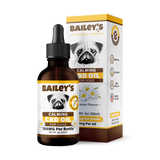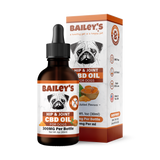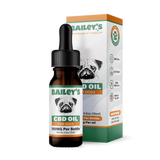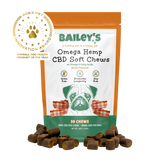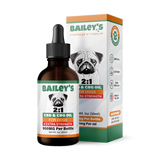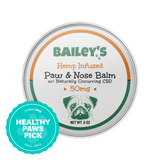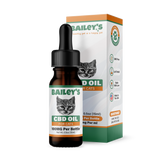CBD for Dogs with Seizures: Everything Pet Owners Should Know

CBD is something that we hear a lot about these days. However, with so much information out there, it can be easy to get overwhelmed and confused about what CBD really is. This is especially problematic because of how closely CBD is associated with THC and marijuana.
But by learning the truth about CBD, you'll see that it can be used effectively to treat both humans and dogs with seizures. Interested in learning more? Continue reading and we'll walk you through how CBD can help improve the quality of life for your furry friend.
Table of Contents
1. What Is CBD?
CBD, or cannabidiol, is one of the hundreds of chemical compounds that are found in the Cannabis Sativa plant. Another prominent compound is THC, or tetrahydrocannabinol.
THC is an intoxicating compound and is responsible for the infamous "marijuana high." CBD, on the other hand, has the ability to relax the body and relieve inflammation, but it doesn't get the user high.
Hemp and marijuana are two types of Cannabis Sativa. The main difference between these two plants is that hemp has high levels of CBD and low levels of THC. Marijuana, on the other hand, has high levels of THC and lower levels of CBD.
2. Seizures in Dogs
Unfortunately, seizures are one of the more common neurological disorders in dogs. A seizure can also be called a fit or convulsion. It's essentially an involuntary and temporary disturbance of normal brain operation that's usually accompanied by uncontrollable muscle spasms.
When a dog has multiple episodes of seizures, it's said to have epilepsy. When a dog has epilepsy, their seizures can occur at regular intervals or seemingly at random.
There are a variety of causes for seizures. The most common cause of seizures in dogs is idiopathic epilepsy. Other causes can include kidney failure, brain trauma, liver disease, toxins, or brain tumors.
A seizure is most likely to take place during a time of changing brain activity. This can be when you're little guy gets excited or they're about to eat. It's also common when you're dog is waking up or about to fall asleep.
Between seizures, a dog can act totally normal.
2.1 What Happens During a Typical Seizure?
A seizure usually consists of three parts. First, there is the pre-ictal stage. This is the period where you'll notice altered behavior in your dog.
They might seem nervous, they may try to hide somewhere, or they will seek out their owner. Your dog might also be whining, salivating, restless, or shaking.
This can last for just a few seconds or several hours. This stage comes before the actual seizure activity and gives the impression that the dog can tell that something is about to happen.
Next is the ictal phase. This stage can last only a few seconds or it can go for several minutes. It can also vary in appearance.
A mild ictal phase can consist of slight changes in mental awareness. Examples include slight shaking, licking lips, having a dazed look, and staring aimlessly. However, some dogs experience a total loss of body function and consciousness.
If your dog experiences a full-on seizure with loss of consciousness, also known as a grand mal, all of the muscles in their body will move erratically and spastically. The dog will usually fall over onto its side and paddle its legs, while the rest of its body seems to be paralyzes.
The head will usually tilt backward too. Salivation, defecation, and urination might also occur.
Lastly, there is the post-ictal phase. This is the period right after the seizure ends. Your dog will likely exhibit disorientation, pacing, confusion, salivation, restlessness, and possibly even temporary blindness.
It's worth pointing out that the duration of the post-ictal phase isn't related to the severity of the seizure.

Image courtesy of: Outlook - Releaf
3. CBD and Seizures
As we can see, seizures can be a terrifying thing. For both dogs and their owners. And you only have to see it happen once to know that you never want your pet to have to go through that again.
And although we know a lot about seizures today, there's still so much more for scientists to learn. Many traditional seizure medications come with dangerous side effects or simply don't work.
This is part of what makes the research into CBD so exciting. In one study from 2016, 89 percent of epileptic dogs that were given CBD experienced a reduction in the frequency of seizures.
In fact, CBD is so effective at treating seizures, that the only drug approved by the Food and Drug Administration which contains CBD is designed to treat seizures.
The power of CBD's effect on seizures became most well known with the case of Charlotte Figi. Charlotte was a young girl you would experience several hundred seizures every day. But after taking CBD, those seizures were reduced to just a few a month.
So, how exactly does CBD work? And why is it so effective at treating seizures?
4. How Does CBD Work?
Within the brain, there are a large number of highly specialized cells, known as neurons. Every neuron connects to many other neurons through bridges called synapses. The synapse is the structure where communication between neurons takes place.
Neurons are able to communicate with each other by sending neurotransmitters, which are chemical messengers. A neuron's ability to interact with a certain neurotransmitter depends on whether the neuron has a receptor that will "fit" the transmitter. If it doesn't fit, then it can't communicate.
Brain receptors can communicate with neurotransmitters that are naturally produced within the body or with messengers that come from outside of the body, such as CBD or THC. So when you ingest CBD, the compound travels through the bloodstream and goes to the brain.
Within the brain is the endocannabinoid system (ECS). This is the area that is the most receptive to CBD and THC. Still, CBD doesn't interact directly with two common cannabinoid receptors - CB1 and CB2.
The fact that it's an indirect interaction helps explain why CBD can affect the brain without making the user high.
CBD is also able to enhance the activation of serotonin 1A receptors. This implies that CBD could treat disorders including opioid dependence, depression, nausea, and neuropathic pain.
The CB2 receptor tends to have the greatest impact on your dog's seizure treatment. In fact, it's believed that epilepsy and seizures can alter the ECS. We now understand that CBD can improve the control of seizures in certain patients.
5. The Entourage Effect
No, we're not talking about getting your dog a puppy entourage (although that would be adorable). Instead, we're referring to the benefits of full-spectrum CBD. The word entourage defines a group of people who surround and encourage an important person.
In this scenario, that important person is the CBD. And the supportive characters are made up of other cannabinoids (CBG, CBC, CBN, etc.), as well as terpenes, flavonoids, and other chemical compounds in the cannabis plant.
In order to achieve the entourage effect, you have to ingest CBD along with other compounds from the cannabis plant. This is instead of taking a CBD isolate.
The point is that, by using the entire hemp plant instead of just one aspect of it, you'll receive an increase in the health benefits. And you'll also be able to boost the overall therapeutic effect of the individual compounds. Essentially, the sum is greater than its parts here.
5.1 What are Cannabinoids?
A cannabinoid is a chemical that interacts with the endocannabinoid system. Examples of cannabinoids include CBD and THC. There are hundreds of different cannabinoids in hemp, but CBD and THC are the most prominent.
With that said, there are other types of chemical compounds that can be found in cannabis too.
5.2 What are Terpenes?
A terpene is a chemical that gives a plant a certain taste or smell. There are many terpenes that you likely come into contact with on a regular basis. Some common terpenes include:
- Linalool, the main component of lavender
- Pinene, from pine resin
- Nerolidol, found in lemongrass and ginger
- Limonene, found in citrus fruit peel
- Mycerne, found in mangos
- Eucalyptol, from tea tree and eucalyptus
If you've ever noticed that pleasant sharp smell hat hits you when you peel an orange, that's caused by a terpene. What's even cooler is that all of the terpenes listed above can actually be found in the Cannabis Sativa plant!
With that said, there are hundreds of different strains of cannabis out there. And each has different levels of terpenes. But terpenes go much further than giving off pleasant smells.
When you mix these terpenes with CBD oil, you end up with synergistic effects. For example, pinene can increase one's alertness and limonene can elevate your mood. Eucalyptol has anti-bacterial properties and nerolidol can actually boost the effects of other compounds that it interacts with.
5.3 Cannabinoids Vs Terpenes
Taking pure CBD on its own can lead to an improved sense of well being and can help with joint inflammation. But when you add terpenes, you can enhance all of those effects.
6. Different Spectrums of CBD
While it might sound attractive to give your dog "pure" CBD, this is actually something worth reconsidering. Instead, you should give your pup high-quality CBD oil that is either broad-spectrum or most preferably full-spectrum.
A broad-spectrum CBD oil is one that comes with some additional cannabis compounds. Oftentimes, these products will also include many beneficial terpenes.
They might also come with other cannabinoids, such as CBG or CBC. Most broad-spectrum CBD products usually don't contain any THC in them.
The best kind of CBD oil, however, is full-spectrum CBD. This supplement will contain all of the cannabis compounds that can be found in the cannabis plant. And as long as the CBD comes from the hemp plant, it will have less than 0.3% THC in it.
With such a low THC level, you can rest assured that your dog won't be getting intoxicated. Full-spectrum CBD also gives your dog the best chances for experiences the full benefits of the entourage effect.
With full-spectrum CBD oil, you can expect the product to contain:
- CBD
- terpenes
- fatty acids
- other cannabinoids
- flavinoids
Each of the chemical compounds listed above can help contribute to the entourage effect. CBD can also be blended with additional terpenes to induce specific effects, such as relieving stress or treating insomnia.
7. How Much CBD Oil Should My Dog Take?
The amount of CBD that you give your dog will depend on his size. The smaller the dog, the lower the dose you will have to give them. And vice versa for larger dogs.
You generally want to go by your dog's weight and also follow any instructions on the label.

CBD oil also comes in different products. Only you know your dog well enough to determine if they will prefer a chewable treat or a tincture.
And while veterinarians can't prescribe CBD, it's still good to talk with your pup's vet about CBD. This is especially true if your dog is on any medications.
8. Using CBD to Help Dogs With Seizures
As we see, CBD is a powerful and exciting new way to help dogs with seizures. And if you want your little guy to live his most puptastic life, then you want to make sure that he's as seizure-free as possible. Just make sure to always read the label and make sure that you're buying high-quality and full-spectrum CBD products.
Your dog will thank you for it.
Are you looking for the right CBD product for your canine? If so, contact us today and see what we can do for you!

